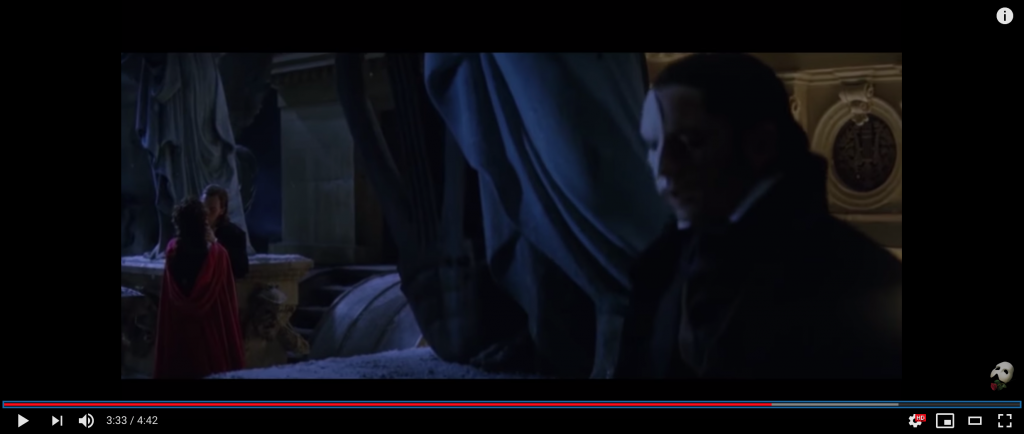Music video can have a huge impact on the song — it can either enhance the feeling/meaning of a song or completely ruin the song. Of course, this is a based on subjective opinions. Andrew Lloyd Webber is most well-known for his Broadway music in his film productions. One of the most famous of them all is the Phantom of the Opera, which is also highly recognized for its incredible soundtracks. The song All I Ask of You is a great depiction of how the video/camera techniques work with the music itself to produce the music video that is highly praised by thousands of audiences.
The setting of the video already creates an atmosphere that relates to the character of the song, a snowy, dark day. It begins with an instrumental introduction that is a series of chords leading to the singing. The third chord is such a magical change that lines up directly with the drop of the rose. Once the singing starts, the camera switches focus depending on whose singing and that really allows the audience to engage with the music and video simultaneously. Worthy to note, the frame switches to a glance of Phantom at 1:20 and that enhances the intensity of the scene. Additionally, they do a good job of connecting the lyrics to the physical actions. For example, when Raoul sings “Let me be your shelter…” he hugs Christine and these little actions is what makes the song more powerful. Also, just throughout the video, the camera angle zooms out when it reaches more climatic moments, allowing the audience have a fuller sense of the atmosphere. One of the most heart-wrenching scenes is when Phantom sees Raoul and Christine kiss and the camera captures the entire frame, which makes the scene that much more captivating.
One comment said, “I always had a sinking feeling that Christine was betraying the phantom, that she left his deep devotion to her for a petty boy who gave her flowers and was nice to look at, until I realized just recently that Christine’s love for Erik is Stockholm syndrome, and Raul is leading her out of a lifelong deception and swirling nightmare geniusly designed by Erik to trap her. I listened to this song for the millionth time once and realized that until she loved Raul she didn’t realize what she had wasn’t true.” This person’s in-depth observation of this music video shows that Webber and film director succeeded in their production because the commenter was able to capture how the actions are related to singing to portray certain feelings. Their reaction is definitely a good representation of what the music video is trying to display. Another comment said, “Probably THE most romantic song I’ve ever heard.” This person’s reaction is clear that the emotions of the song were delivered effectively, in order for the audience to feel emotionally connected. Additionally, another viewer commented, “Andrew Lloyd Webber: a freaking genius.” Just this one sentence is enough to show how powerful the music video is. With all these positive reactions, along with many more in the comments section, it is clear that this video evoked their meanings and feelings successfully. On another note, as I scrolled through the comments and actually did not find any negative observations, which is also a sign that the video was effective. All these comments show that technology allows us to directly communicate our thoughts or find relatable comments to agree with. It also expands the diversity of audiences because everyone is able to search for it.
As we can see, this music video delivers a strong performance through the coordinations of the music, actors, and directors. This is personally one of my all-time favorites and a huge reason is because of how well every aspect of video comes together to create the memorable experience of one of the most romantic songs. : )





